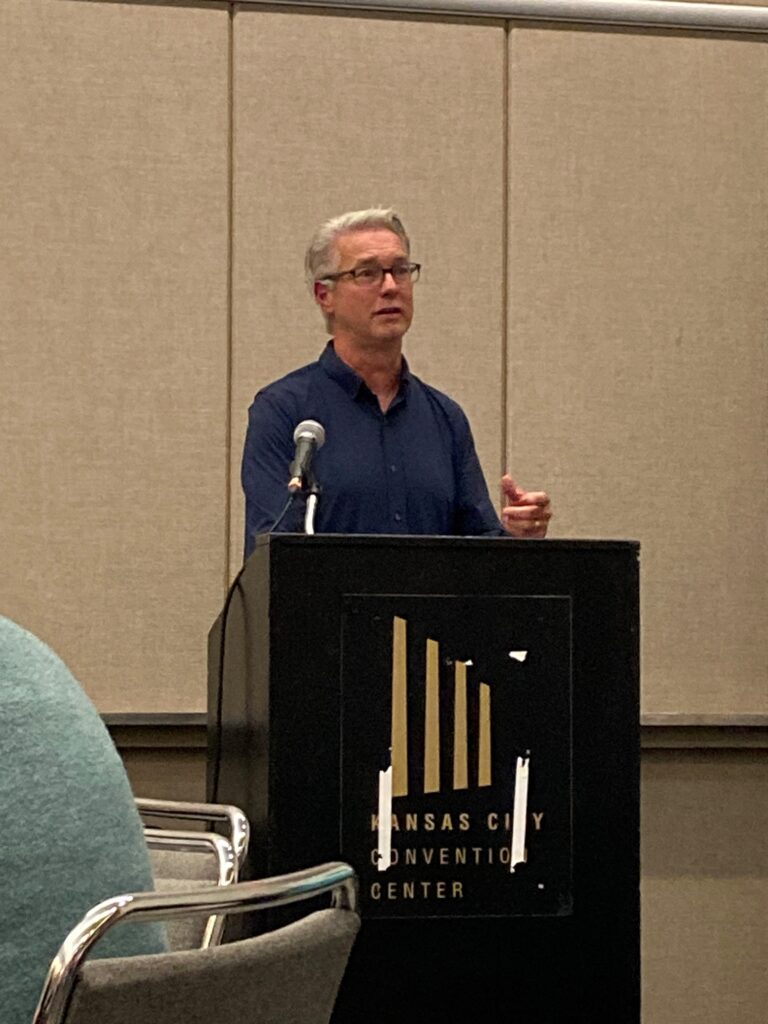by Jolene VonGunten

It was standing room only for Michael Danner’s talk, “Making Decisions Together,” Wednesday afternoon at MennoCon23. Danner spoke out of his dual role as the Associate Executive Director of Church Vitality for Mennonite Church USA (MC USA) and as the Executive Director of Mennonite Education Agency. He also drew from his experiences as a longtime pastor at Metamora (Ill.) Mennonite Church and as conference minister for Illinois Mennonite Conference. He has seen decision-making processes at the local congregational level, at the area conference level, and at the national denominational level.
Danner invoked the Anabaptist principle of a priesthood of believers, rooted in the gifts of the Spirit. The community discerns together what God is calling them to and how to move forward in mutual accountability to one another.
But is this how decision-making actually happens? Somehow, these ideals often are not realized in practice. The role of the structure and polity of a church, Danner noted, is to embody and help make the group’s common values and beliefs happen. “Does the polity and decision-making processes and ways you order your common life together actually help you become who say you are?” Danner asked. “What we end up doing together often doesn’t bring out the essence of who we are as a community.”
How do we think about what it means to make decisions together and what are the practical things we can do that might be helpful to us? Danner offered eight insights.
Communities are created one room at a time. Every gathering is an opportunity to build relationships, accountability, and commitment. It is an opportunity to strengthen the fabric of the community. We build “relatedness,” Danner explained, by helping people move from isolation to a sense of belonging. He referred to Peter Block’s book “Community: The Structure of Belonging” to define belonging as being a part of something. It is “the experience of being at home, and the opposite of thinking that wherever I am, I would be better off somewhere else…. to know even in the middle of the night, that I am among friends.”
It also means a sense of ownership. If you belong to a community, then you are part creator and part owner of that community. That means you’re actually responsible for the quality of that community and the decisions the community makes. You also are accountable to care for the well-being of the whole community with no expectation of anything in return.
Danner said at the end of any discernment gathering, he would hope the participants would leave with a greater sense of belonging to the community and responsibility for it with no promise of anything in return. A little bit like Jesus, Danner noted.
Pay attention to the physical space. Different spaces have different functions, Danner said, and how these spaces make us feel matters. We can arrange or rearrange rooms to help support our intention to reduce isolation and build relationships. Danner recommended meeting in a circle – the symbol of community – so everyone can see each other and read people’s expressions and body language.
Windows and being able to see the outdoors are ways to stay connected with the world. Bring pieces of nature inside if windows are not an option.
Danner emphasized that all voices must be heard equally and be amplified as needed.
Be mindful of physical dynamics in the room and if people with common points of view seat themselves near each other. The leader of the gathering can reconfigure the room based on who comes into that space so that all participants are on the same level.
All of this is consistent with our Anabaptist values, Danner said.
The small group is the unit of transformation and moves a community towards greater faithfulness. The small group is the key to big changes, Danner explained. Large-scale transformations occur when enough small groups shift. “The small group is the bridge between our own individual existence and our community,” he said. Danner encouraged any delegates present to consider their table groups during Delegate Assembly later this week as bridges into the larger community. Table groups are great ways to ensure that every person connects with someone, especially in large assembled groups. It is a safe way to be engaged without being either put on the spot or ignored.
Smaller groups also offer a self-correcting quality to manage disagreements. The others at the table can help people reach an understanding that would never happen in a large group setting.
Leaders play a key role in transformation, but it’s not what you think. The role of the leader is not to fix a problem, Danner said, or to give you the answer, or tell you what to do. Rather, “transformative leaders help groups move from a place of fear and fault to one of gifts, generosity, and abundance.” Danner referred to the concept of gelassenheit, the idea that we voluntarily choose to enter into a relationship of mutual submission and accountability to each other.
Transformative leaders intentionally strengthen the fabric of the community. Our relationships are central to the community. Systems, rules, and documents won’t save us, Danner said. These things are very important, but associational, relational life is central. And the focus should be kept on the community, not its leaders. Good leaders need to help communities be responsible for their own issues and concerns. Good leaders help us function the way we say we want to function. For Anabaptists, that is through Spirit-led, prayerful, scripture-directed discernment with equal room for all voices and gifts.
Know and be on the lookout for signs of a stuck community within your gatherings. A stuck community is always marked by fear and fault. We fear something is threatening our community and someone is at fault. The community becomes focused on eliminating the source of our fear.
Another sign of a stuck community is an increase in laws and oversight, Danner noted. Distrust occurs as leaders begin to believe that we are incapable of monitoring and controlling ourselves.
The future turns on moving from a retributive community to a restorative community. The Gospel is not a commodity, and the church is not a vendor of religious goods and services, Danner said. We are not passive consumers. Being a part of a community means we’re fully invested, responsible and accountable for the well-being of the whole.
Ask transformational questions. Good questions invite people to bring their personal feelings and experiences into the space and provide insight into their points of view. Danner said good questions may provoke some anxiety because they are touching on things that actually matter. He closed by offering some examples of transformational questions.
“What is at stake for you in this?”
“What is the commitment you hold that brought you into this room?”
“What is the price you or others pay for being here today?”
“How valuable do you plan for this effort to be?”
“What is the story you keep telling yourself about the problems in this community?”
“What are the gifts you hold that have not been brought fully into this space?”
“What are you holding back that might make a difference in the way this community functions?”
“What is your contribution to the thing you’re complaining about?”
“What is it about this community that you’ve valued.”

